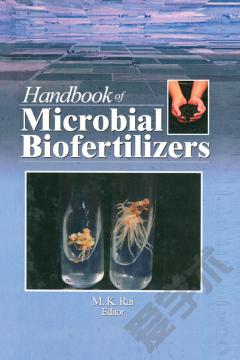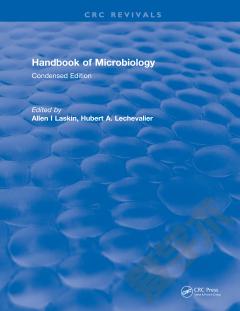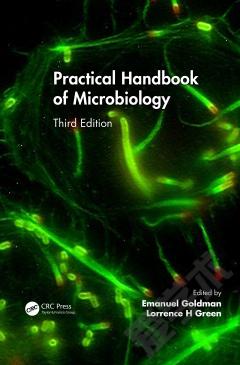Handbook of Microbial Biofertilizers
* About the Editor * Contributors * Foreword (Ian Robert Hall) * Preface * Acknowledgments * Chapter 1. Potential and Possible Uses of Bacterial and Fungal Biofertilizers (Francesco Gentili and Ari Jumpponen) * Introduction * N2-Fixing Bacteria As Microbial Biofertilizers * Symbiotic N2-Fixing Bacteria * Cyanobacteria * N2-Fixing Associated Bacteria * Free-Living N2-Fixing Bacteria * Plant-Growth-Promoting Rhizobacteria * Phosphorus-Solubilizing Bacteria * Plant Hormone Production by Bacteria * Fungi and Their Potential As Biofertilizers * Use of Arbuscular Mycorrhizal Fungi As Biofertilizers * Use of Ectomycorrhizal Fungi As Biofertilizers * Other Root-Colonizing Fungi * Multiple Inoculations and Interactions Among Potential Biofertilizers * Future Perspectives and Conclusions * Chapter 2. Evaluation of the Functional Group of Microorganisms As Bioindicators on the Rhizosphere Miscrocosm (Ulisses Brigatto Albino and Galdino Andrade) * Introduction * The Functional Groups * Methods to Assess the Soil Functional Microorganism Groups * Protocols * Future Perspectives * Conclusions * Chapter 3. Tripartite Relationship of Rhizobium, AMF, and Host in Growth Promotion (Nanjian Raman and Thangaswamy Selvaraj) * Introduction * Rhizobium and AMF Interactions * Rhizobium, AMF, and Biochemical Activities * Enzyme Activities * Growth Hormones * Calcium and Phosphorus Requirements * Heavy Metals * Plant Uptake of Metals * Plant-Growth-Promoting Rhizobacteria * Coexistence of Rhizobium and AM Symbioses * Conclusions and Future Perspectives * Chapter 4. Biological Fertilizers for Sustainable Rice Production (S. Kannaiyan and K. Kumar) * Introduction * Azolla Biofertilizer for Rice Crop * Nitrogen-Fixing Blue Green Algae * Acid-Tolerant Cyanobacteria * N2-Fixng Stem-Nodulating Sesbania Biofertilizer for Rice * Sesbania As Biofertilizer for Rice * Neem Cake and N Use Efficiency * Urea Super Granules and N Use Efficiency * Soil Enzyme Activity * Induction of Nodule-Like Structures in Rice Roots for N2 Fixation * Azospirillum Biofertilizer for Rice * Phosphobacterial Biofertilizer * Future Perspectives * Conclusions * Chapter 5. Mycorrhizal Helper Bacteria: Their Ecological Impact in Mycorrhizal Symbiosis (Robin Duponnois) * Introduction * The Mycorrhizosphere Effect * Evidence * Biological Properties * Mechanisms Involved in the MHB Effect * Application * Conclusions and Perspectives * Chapter 6. Plant-Growth-Promoting Rhizobacteria As Biofertilizers and Biopesticides (Manas Ranjan Banerjee, Laila Yesmin, and Joseph Kevin Vessey) * Introduction * Biofertilizers * Endophytic and Rhizospheric Relationships Between PGPR and Their Hosts * Mode of Action of PGPR As Biofertilizers * Biopesticides * Mode of Action of PGPR As Biopesticides * Viability and Shelf Life of PGPR * Benefits of PGPR * Limitations of PGPR * Future Perspectives * Conclusions * Chapter 7. Sustainable Agriculture and the Rhizobia/Legumes Symbiosis (Joao Ruy Jardim Freire and Enilson Luiz Saccol de Sa) * Introduction * Diversity of Rhizobia * The Selection of Rhizobia Strains * Desirable Characteristics * Production and Quality of the Inoculants * Techniques of Inoculation * Soil Limiting Factors * Some Management Practices * Future Perspectives * Conclusions * Chapter 8. Wild-Legume Rhizobia: Biodiversity and Potential As Biofertilizer (Hamdi Hussein Zahran) * Introduction * Taxonomy and Biodiversity of Wild-Legume Rhizobia * Symbiotic Nitrogen-Fixing Systems Established with Wild Rhizobia * Behavior of Wild-Legume Rhizobia Under Extreme Conditions * Future Perspectives * Conclusions * Chapter 9. Potential of Arbuscular Mycorrhizae in Organic Farming Systems (Tanu, Anil Prakash, and Alok Adholeya) * Introduction * Mycorrhizae in Organic Farming * Factors Affecting Mycorrhizal Inoculum Potential * Selection of AM Fungi * Integration of AM Fungi and Composts for Disease Control * Organic Manure and AMF Inoculum Production * Application of AM Fungi * Future Perspectives * Conclusions * Chapter 10. Role of Mycorrhizae in Forestry (Hanna Dahm) * Introduction * Ecological Significance of Mycorrhizae * Types of Mycorrhizae on Forest Trees * Occurrence of Mycorrhizal Fungi in Soils of Native Forests * Soil Type and Humus Properties * Ecological Specificity * Competition Among Ectomycorrhizal Fungi in Forest Soil * Favorable Effects of Mycorrhizae on Plant Growth * Factors Affecting Ectomycorrhizal Reduction * Receptiveness of Forest Soils to Ectomycorrhizal Association * Practical Aspects of Mycorrhizae: Perspectives * Conclusions * Chapter 11. Physiological and Molecular Aspects of Osmotic Stress Alleviation in Arbuscular Mycorrhizal Plants (Juan Manuel Ruiz-Lozano) * Introduction * Uptake and Transfer of Water Through the Fungal Hyphae to the Host Plant * Amelioration of Plant Gas Exchange * Changes in the Water Retention Properties of the Soil * Stimulation of Assimilative Activities Essential for Plant Growth * Osmotic Adjustment * Protection Against the Oxidative Damage Generated by Drought * Future Perspectives and Conclusions * Chapter 12. Arbuscular Mycorrhizal Inoculation in Nursery Practice (Miguel Marin) * Introduction * Types of Mycorrhizae * Mycorrhizae Effects on Plant Physiology * Interaction of Arbuscular Mycorrhizal Fungi with Soil Microbiota * Mycorrhizae As Substitute for Fertilizers * Mycorrhizal Symbiosis in Horticultural Systems * Endomycorrhizal Technology in Different Propagation Systems * Management of Arbuscular Mycorrhiza in Nursery Plant Production * Future Perspectives * Conclusions * Chapter 13. Interaction Between Arbuscular Mycorrhizal Fungi and Root Pathogens (Leonor Costa Maia, Norma Suely Sobral da Silveira, and Uided Maaze Tiburcio Cavalcante) * Introduction * Root Colonization * Changes Produced by Mycorrhization * Interaction: Arbuscular Mycorrhizal Fungi and Plant Pathogenic Fungi * Arbuscular Mycorrhizal Fungi à Bacteria * Arbuscular Mycorrhizal Fungi à Nematodes * Future Perspectives * Conclusions * Chapter 14. Production of Seedlings Inoculated with Arbuscular Mycorrhizal Fungi and Their Performance After Outplanting (Orivaldo Jose Saggin-Junior, and Elaine Maria Ribeiro da Silva) * Introduction * Prerequisites for the Inoculation of Seedlings with AMF * Production of Inoculants for Seedlings * Production of Seedlings Inoculated with AMF * Future Perspectives of Mycorrhizal Seedling Production * Conclusions * Chapter 15. Status of Endomycorrhizal (AMF) Biofertilizer in the Global Market (Polachi Raja) * Introduction * World Fertilizer Consumption * Alternative Farming Systems * Sustainable Agriculture Systems * Effective Microorganisms * Evolution of AMF * Techniques of AMF Inoculum Propagation * AMF Benefits of Symbiosis * Impact of AMF in Agriculture * Availability and Cost of Mycorrhizal Inoculum * Producers and Formulators of AMF Inoculum * Future Perspectives * Conclusions * Chapter 16. Role of Cyanobacteria As Biofertilizers: Potentials and Limitations (Pilar Irisarri) * Introduction * Current Status of Cyanobacterial Use As Biofertilizers * Availability of Fixed Nitrogen to Rice Plants * Cultivation of Cyanobacteria for Biofertilizer * Inoculation and Crop Yield * Reasons for the Failure of Inoculation * Benefits of Cyanobacteria Beyond Nitrogen Input to the Agroecosystem * Is Inoculation with Cyanobacteria Worthwhile? * Integrated Soil Fertility Management * Future Perspectives * Conclusions * Chapter 17. Cyanobacterial Biofertilizers for Rice: Present Status and Future Prospects (Siba Prasad Adhikary and Bagmi Pattanaik) * Introduction * Cyanobacteria (Blue-Green Algae) * Factors Governing Distribution of Cyanobacteria During the Crop Growth Cycle * Seasonal Variation of Cyanobacterial Growth in Paddy Fields * Phosphorus * Cyanobacteria Biofertilizer for Increased Crop Yield and Maintenance of Soil Quality * Algalization Technology * Future Perspectives * Conclusions * Chapter 18. A Comparative Study on Nitrogen-Fixing Cyanobacteria in South American and European Rice-Fields (Carlos Hugo Porsperi) * Introduction * Measuring Nitrogen Fixation in the Field * Determination of Nitrogenase Activity in Vivo * Samples Collection and Identification * The Diversity of Cyanobacteria * Future Perspectives * Appendix: Identification Key for Most Common Cyanobacteria in Rice Fields of Argentina and Spain * Chapter 19. Piriformospora indica As a New and Emerging Mycofertilizer and Biotizer: Potentials and Prospects in Sustainable Agriculture (Sarika Shende, Kanchan Bhagwat, Prasad Wadegaonkar, Mahendra Rai, and Ajit Varma) * Introduction * The Morphology and Cultural Characteristics * Mycelial Penetration in Host * Ultrastructure of Hyphal Wall * Molecular Systemetics * Root Colonization Potential in Diverse Hosts * In Vitro Rapid Proliferation of Roots of Withania somnifera * Rhizoctonia-Like Growth Promotion of Orchids * Enhancement of Secondary Metabolites * Mechanisms Involved During Colonization * Mycorrhiza-Like Endophytes * Protoplast Fusion for Better Understanding of Interaction * Strategies for Mass Production of Inocula * Immobilization of Spores and Hyphae: A Step Forward for Inoculum Production * Application in Horticulture * Potential for Control of Phytopathogenic Rootborne Microbes * Conclusions and Future Directions * Chapter 20. Matsutake: A Natural Biofertilizer? (Wang Yun and Ian Robert Hall) * Introduction * Matsutake in the Commercial World * Taxonomic History of Matsutake * Ecology * Morphology of Matsutake Infections * Cultivation of Tricholoma matsutake * Relationship Between Matsutake and Its Host Plants * Future Challenges * Conclusions * Index * Reference Notes Included
{{comment.content}}








 京公网安备 11010802027623号
京公网安备 11010802027623号